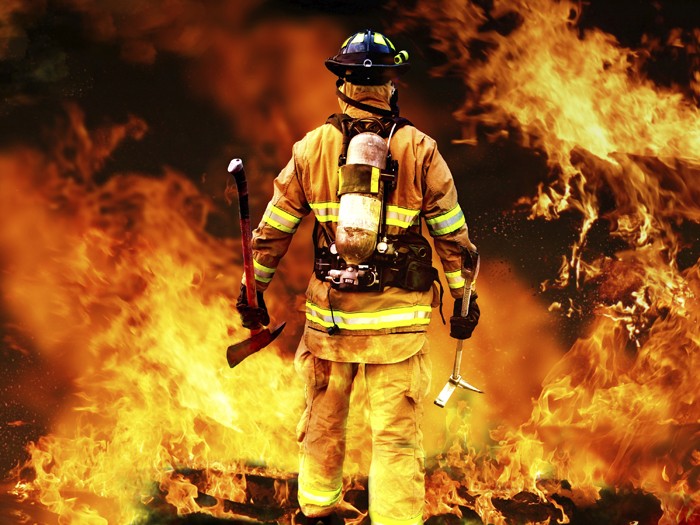Property Perils
Fire Risks Simmer in New Construction

Lightweight wood construction has enabled developers to use unused and underused properties to build multi-family structures quickly and inexpensively.
The downside is that in a fire, the thin wood and laminate burns quickly, as graphically demonstrated last year when complexes under construction in San Francisco and Houston were destroyed. (See R&I story: Hot Targets: Upscale Urban Projects.)
The vulnerability of mid-rise wooden structures was brought more ominously to national attention earlier this year by a fast-moving fire that gutted the fully occupied AvalonBay residential complex in Edgewater, N.J.
The fire was clearly visible across the Hudson River in Manhattan. There were no serious injuries but more than 1,000 residents lost everything.
The blaze was caused by maintenance workers using a blowtorch for plumbing work in the walls, and spread quickly through connected attic spaces. Insurance sources familiar with the claim said that partitions in the complex designed as fire breaks had been penetrated for utility access.
“The purpose of [fire] codes is not to prevent the building from burning down, but rather to ensure that there is sufficient time and opportunity for all occupants to exit safely in the event of a fire.” —Michael Feigin, chief construction officer, AvalonBay
“There is a lot of light, quick construction these days, because it is cheaper and faster,” said Michael Pilla, CEO of Technical Risk Underwriters (TRU), part of Ryan Specialty Group Underwriting Managers.
“For owners, the sooner they can lease the property, the better. On a $100 million project, an extra 15 percent for steel structural units is not just $15 million, it is also more time and expense to build, because skilled labor is stretched thin in the construction trades. Nail gunning is easier and faster and there are more workers who can do it.”
The complex was built in compliance with fire and safety codes, said Michael Feigin, chief construction officer for developer AvalonBay, after the fire.
He added that “the purpose of those codes is not to prevent the building from burning down, but rather to ensure that there is sufficient time and opportunity for all occupants to exit safely in the event of a fire.”
Therein lies the problem for residents and underwriters: how best to protect structures that are not built to withstand more than a few minutes of fire.
“We say the choice is to build to code or to build to last,” said Brion Callori, senior vice president of engineering and research at FM Global. “The Edgewater fire is a perfect example of that. It was built in compliance with National Fire Protection Association [NFPA] codes.”
The best option, said Callori, is sprinklers, but retrofitting those into existing structures is difficult. Treatments also have their limitations.
“Wood burns,” he said. “Passive fire protections, such as coatings, are a challenge in original construction because they may not last the life of the building.”
Coatings are also a challenge in retrofits because it is difficult to get to all surfaces. At best, coatings will slow a fire, but cannot stop it, he said.
“We have seen a lot of treated lumber and sprays for fire resistance,” said Pilla, “but it’s still wood — and wood burns. We write a large amount of large structures and we have found that the best practice is for owners and managers to stick rigorously to the NFPA codes.
“We inspect every property as frequently as every three months for every NFPA code and cite ‘SCARE’ instances — serious conditions affecting risk exposures. We note them and let the owners or operators know we will be back. You would be surprised how often you see the same issues over and over.”
Based on lessons learned from actual losses as well as at FM Global’s research and testing center in Providence, R.I., Callori said, “We are focusing on ways to reduce the cost of sprinkler systems in both original construction and in retrofits. They look simple, but they are really very complex systems.”
The current focus for FM Global is original and retrofit sprinklers for warehouses, where ceilings and shelves are going higher and higher, and more plastic is being used.
Shortcuts Turn Into Tragedies
Beyond the challenges of physics, chemistry and engineering, the biggest hurdle for insurers may be the soft market, said Callori. “Our underwriting is tied to engineering, and upgrades or retrofits can lead to lower premiums, but that is not what drives things. Rates are market driven and currently there is a soft market.”
Another complication reported by both carriers and owners is the complexity of the codes.
TRU has consolidated the NFPA mandates into a summary booklet called the Builders Risk Tool Box. “Our engineers have written protocols using the NFPA codes, and even included sample permits. Our tack is prevention. There are a lot of competitors in this market and a lot of capacity.”
Pilla is quick to note that contractors, owners and operators with better loss histories usually have their own protocols.
“The prudent contractor exceeds the standards. Where we find problems is when someone skips a step, like having a fire extinguisher at hand during hot work. In the time it takes to run and find a fire extinguisher, a fire can grow. We also see situations where crews left the job too soon and something smoldering flared up.”
The problem is worse with renovations, rehabs and retrofits, because those are often done with far fewer people and on a much smaller scale.
“In a new build,” said Pilla, “there are lots of people on the job. There are inspectors, and you can see almost everything. In a rehab, it could just be a few workers working in one space at a time. [There is] often less supervision and less ability to see potential hazards.”
One industry source with close knowledge of the Houston, San Francisco, and Edgewater fires said that uncontrolled hot work, such as was the case in Edgewater, is one of the top causes of fires.
“Hot work is nasty, and problems are common,” the expert said. “The codes and best practices are sound, but they are often not followed, especially in rehab and retrofit work because crews are often in a rush and are rarely observed.”










